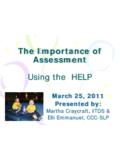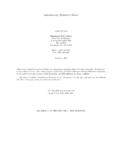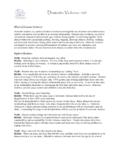Transcription of Executive Managing sickness absence and return …
1 Health and Safety Executive Managing sickness absence and return to work in small businesses On April 6 2010, the revised Medical Statement (the 'Fit Note') was introduced in England, Scotland and Wales. The guidance contained here was first published in 2004 and therefore makes no reference to the Fit Note. We would ask readers of this guidance document to consider how the introduction of the Fit Note has impacted on the good practice contained in it. To help readers in making this consideration, HSE suggests that they refer to the relevant guidance on the introduction of the Fit Note: Employers employer Employees note employee GPs gp OH providers occupational health Health and Safety Executive Managing sickness absence and return to work in small businesses For small employers, an employee off work sick for more Less than 3 days of sickness absence than 14 days is likely to be rare.
2 But when it does Your employee should tell you why they are absent happen, there are considerable benefits from working in from work. partnership with your employees and their trade union and When your employee returns to work, welcome them other employee representatives to help those off work sick back and have a chat about their absence . to return to work. Between 4 and 14 days of sickness absence By doing this you will: Keep in touch with your employee. keep valued staff and avoid unnecessary recruitment When your employee returns to work, conduct a return and training costs; to work interview. This in many cases will be a simple keep your business productive, and where your sick welcome back but you may need to discuss actions to employee has built up a loyal client base, keep this as help your employee's performance at work or underlying a source of income; issues if short-term absence is frequent.
3 Reduce unnecessary overheads, eg saving on lost wages and sick pay costs; Between 15 and 28 days of sickness absence help meet your legal duties and avoid discriminating Keep in touch regularly with your employee and identify against disabled workers; the barriers that prevent returning to work (many of maintain and improve workplace relations by these will not need a medical solution). working in partnership with your employees and their You may need to consider expert advice, eg doctors, workforce representatives. occupational health and rehabilitation providers. Welcome your employee back and conduct a return to Tell your employees what they can expect from you to work interview. help them return to work, as far as your business permits. If it seems your employee is not likely to return to work Make sure they understand their own contractual duties to soon then talk to them about the need to consider a you, including what procedures you require for absences return to work plan.
4 From work. But it is important to have a fair and consistent approach to return to work and for you and your employees After 28 days of sickness absence and their representatives to be honest and trust each other Continue to keep in touch regularly with your employee at every step of the process. The sooner you take positive about their absence . action in partnership with your employees and their Put together a plan of actions and reasonable representatives, the more likely it is that your sick employees adjustments to help your employee return to work, can return to work successfully and get on with helping you including seeking expert advice if necessary, and agree build your business. these with your employee and others involved. Welcome your employee back and implement the plan. Review your employee's return to work progress until What can be done they resume their full duties.
5 Tell your employees that it's your policy to help them return to work following sickness absence . Explain to your employees Sometimes, even with everybody's best efforts, it is not that returning to work will benefit them with improved health possible to return your sick employee to full or even partial and wellbeing and with more pay in their pocket. employment, but it is important not to jump to conclusions before alternative solutions have been explored. You may Record and monitor all sickness absence . You may be well need to consider seeking expert advice before making aware which of your employees is off work sick, but it is still any decisions. important to know the cause of their sickness , in case it is work-related. If it is, you can put in place organisational measures, ie modified work, including reasonable adjustments, that will help them and those who are sick in the future to return to work.
6 Health and Safety Executive Remember, as an employer, you have duties under the Further information following legislation: HSE priced and free publications are available by mail order The Health and Safety at Work etc Act 1974 to ensure from HSE Books, PO Box 1999, Sudbury, that the health and safety of everyone at work is Suffolk CO10 2WA. protected, so far as is reasonably practicable. Tel: 01787 881165 Fax: 01787 313995. The Disability Discrimination Act (DDA) 1995 to make Website: reasonable adjustments to accommodate employees (HSE priced publications are also available from bookshops who are or have become disabled, as defined by the and free leaflets can be downloaded from HSE's website: DDA. The fact that a person has a disability does not ). mean that they represent an additional risk to health and safety. For information about health and safety ring HSE's Infoline You will also have to take account of those rights at Tel: 08701 545500 Fax: 02920 859260.
7 Work your employees have under employment law. e-mail: or write to HSE Information Services, Caerphilly Business Park, More detailed help is available from the HSE guide, Caerphilly CF83 3GG. Managing sickness absence and return to work HSG249. HSE Books 2004 ISBN 0 7176 2882 5 or at This desk aid is available in priced packs of 20 from There is also a leaflet for HSE Books ISBN 0 7176 2914 7 (single free copies are also employees Off work sick and worried about your job? Steps available from HSE Books). you can take to help your return to work INDG397. HSE Books 2004 (single copy free or priced packs of 15 This desk aid is intended to simply provide practical ISBN 0 7176 2915 5). information. Where reference is made to legal duties this should not be regarded as an authoritative statement of the law and for legal advice readers should refer, in the first instance, to the sources signposted in Appendix 5 in the HSE guide on Managing sickness absence and return to work or at Crown copyright This publication may be freely reproduced, except for advertising, endorsement or commercial purposes.
8 First published 10/04. Please acknowledge the source as HSE. INDG399 10/04 C1500. Printed and published by the Health and Safety Executiv













